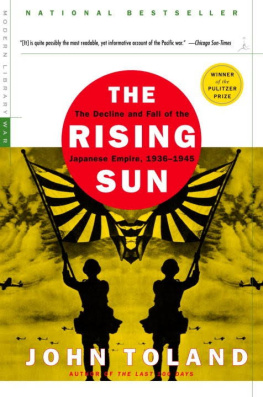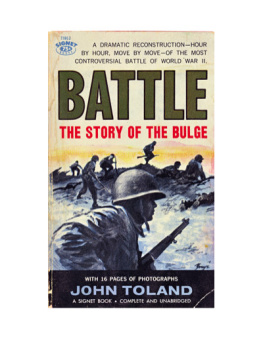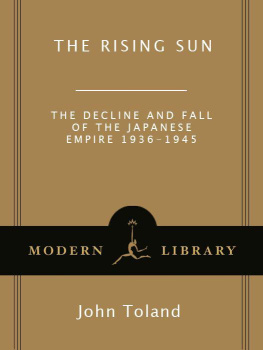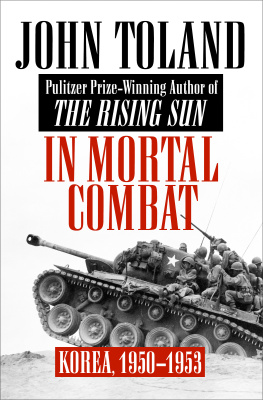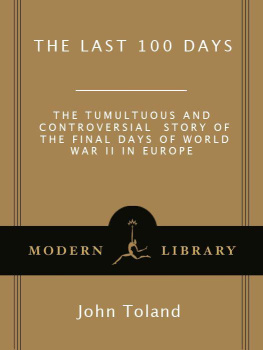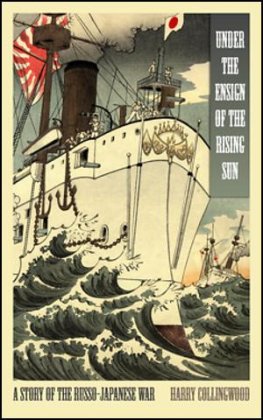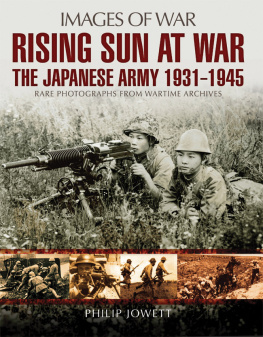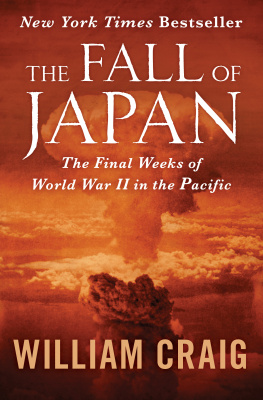2003 Modern Library Paperback Edition
Copyright 1970 and copyright renewed 1998 by John Toland
All rights reserved under International and Pan-American Copyright Conventions. Published in the United States by Modern Library, an imprint of The Random House Publishing Group, a division of Random House, Inc., New York, and simultaneously in Canada by Random House of Canada Limited, Toronto.
M ODERN L IBRARY and the T ORCHBEARER Design are registered trademarks of Random House, Inc.
This work was originally published in hardcover in 1970 by Random House, Inc.
ISBN 0-8129-6858-1
eBook ISBN: 978-0-8041-8095-5
Modern Library website address: www.modernlibrary.com
v3.1
C ONTENTS
M APS

F OREWORD
After World War II most Westerners felt that General Tojo and other Japanese leadersindeed the mass of Japanesewere no better than Hitler and his Nazi cohorts, and deserved whatever punishment and misfortune that befell them.
Twenty-five years have passed and Japan has recovered from almost total moral and economic disaster to resume a respected place among nations of the world. Still, the question remains: How could we have come to admire and respect a people who often acted like barbarians during the war?
This book, which is largely seen from the Japanese point of view, is an attempt to answer that question as well as others about the war that changed the face of Asia. Why did a country the size of California launch the suicidal attack on Pearl Harbor which involved it in a death struggle with an enemy ten times stronger? Was war between the two nations, which today find so much in common, inevitable and essential? Did the winning of that war perpetuate American involvement in Asian affairs?
I would not have attempted to write this bookeven with the assistance of a Japanese wife and her familybut for two things: a drastic change in Japanese attitudes toward their own immediate past and the appearance of significant new documents. In addition to the mountain of material already available in the Japanese Ministry of Foreign Affairs and the Military History Archives of the Japan Defense Agency, valuable documents that had been hidden or lost were recently discovered, such as records of the imperial and liaison conferences, the supposedly burned portions of the Konoye Diary, and the thousand-page Notes of Field Marshal Gen Sugiyama, Chief of the Army General Staff from 1940 to February 21, 1944.
Even more important has been the willingness of Japans former military and civilian leadersincluding Marquis Koichi Kido, the Emperors chief adviser; Prince Mikasa, the Emperors youngest brother; Admiral Ryunosuke Kusaka, de facto commander at Pearl Harbor and Midway; and General Kenryo Sato, perhaps Tojos most trusted confidantto talk freely and at length about the unhappy past. Gone is the reluctance, apparent only a few years ago during research for But Not in Shame, to discuss certain sensitive subjects. Moreover, they are convinced that Westerners, after their postwar experiences in Asia, will have more understanding of the blunders they made in Manchuria and China. Those who fought the war, from generals to privates, have also been more willing to talk of their mistakes, and speak of the unspeakable: cowardice, murder, cannibalism, surrenderand desertion.
In the interest of accuracy these men, as well as everyone else interviewed whose story is included in the book, read the passages about themselves and often added illuminating comments. The dialogue in the book is not fictional. It comes from transcripts, records and stenographic notes, and the memory of the participants. The extensive debates during the various imperial and liaison conferences, for example, are based on the Sugiyama Notes; the recently assembled official records; diaries; and interviews with Marquis Kido, who was given an immediate report of each conference the Emperor attended, and participants including General Teiichi Suzuki, Naoki Hoshino and Okinori Kaya. The Notes (at the end of the book) list sources for all material used, chapter by chapter.
Americas greatest mistake in World War II, I believe, was in failing to recognize that she was fighting two different kinds of war simultaneously: one in Europe against another Western people and philosophy, Nazism, and one in Asia which was not only a struggle against an aggressive nation fighting for survival as a modern power but an ideological contest against an entire continent. Millions of Orientals saw Japans battle as their own, as a confrontation of race and color; they also saw in Japans victories their own liberation from Western domination.
Each nation, the United States not excepted, has made its contribution to the welter of evil which now comprises the Far East question. Tyler Dennett, an authority on the Far East, wrote in 1922: We shall all do well to drop for all time the pose of self-righteousness and injured innocence and penitently face the facts.
If we had done so, it is very probable that our negotiations with Japan in 1941 would have ended in peace, not war, and America would not have been forced to become the moral policeman of Asia for many years. And a moral policemans lot is not a happy one, particularly when his own morality is in question.
What follows is a factual saga of people caught up in the flood of the most overwhelming war of mankind, told as it happenedmuddled, ennobling, disgraceful, frustrating, full of contradiction and paradox. I have done my utmost to let the events speak for themselves, and if any conclusion was reached, it was that there are no simple lessons in history, that it is human nature that repeats itself, not history. We often learn more about the past from the present, in fact, than the reverse. The lessons of our own brutalities in postwar Asia, for example, have undoubtedly given Americans insight into the actions of the Japanese a generation ago.
J.T.

PART ONE
The Roots of War
Gekokujo
The sky over Tokyo on the afternoon of February 25, 1936, was dark and foreboding. A thick blanket of snow already covered the city and there was threat of more to come. Three nights earlier more than a foot had fallen, breaking a record of fifty-four years, and causing such a traffic snarl that some theaters had to be turned into temporary hotels for audiences unable to get home.
Even under its white cloak of snow, Tokyo looked almost as Western as Oriental. Japan had left much of its feudal past behind to become by far the most progressive, westernized nation of Asia. A few hundred yards from the Imperial Palace with its traditional tile roof was a modern four-story concrete building, the Imperial Household Ministry, where all court business was conducted and the Emperors offices were located. Just outside the ancient stone walls and moat surrounding the spacious Palace grounds was the same mlange of East and West: a long line of modern structures, including the Imperial Theater and the Dai Ichi Building, as Occidental as the skyline of Chicago, while a few blocks away, in narrow cobblestone streets, were row upon row of geisha houses,

